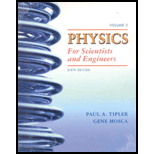
Concept explainers
(a)
Total charge on the sphere
(a)
Explanation of Solution
Given:
Radius of non-
Formula used:
Write the expression for the total charge on the sphere.
Write the expression for the volume
Here,
Calculation:
Substitute
Substitute
Conclusion:
Thus, the total charge on the shell is
(b)
The electric field at a distance
(b)
Explanation of Solution
Given:
Radius of non-conducting sphere is
Formula used:
Write the expression for Gauss’s Law.
Here,
Substitute
Rearrange above expression for
Write the expression for charge enclosed by Gaussian surface for
Substitute
Simplify the above expression for
Calculation:
Since,
Substitute
Conclusion:
Thus, the electric field is
(c)
The electric field at a distance
(c)
Explanation of Solution
Given:
Radius of non-conducting sphere is
Formula used:
Write the expression for Gauss’s Law.
Here,
Substitute
Rearrange above expression for
Write the expression for charge enclosed by Gaussian surface for
Substitute
Simplify the above expression for
Calculation:
Since,
Substitute
Conclusion:
Thus, the electric field is
(d)
The electric field at a distance
(d)
Explanation of Solution
Given:
Radius of non-conducting sphere is
Formula used:
Write the expression for Gauss’s Law.
Here,
Substitute
Rearrange above expression for
Since the total charge on the sphere is enclosed by the Gaussian surface for
Since,
Calculation:
Substitute
Conclusion:
Thus, the electric field is
(e)
The electric field at a distance
(e)
Explanation of Solution
Given:
Radius of non-conducting sphere is
Formula used:
Write the expression for Gauss’s Law.
Here,
Substitute
Rearrange above expression for
Since the total charge on the sphere is enclosed by the Gaussian surface for
Since,
Calculation:
Substitute
Conclusion:
Thus, the electric field is
Want to see more full solutions like this?
Chapter 22 Solutions
Physics for Scientists and Engineers, Vol. 3
- A charge of q = 2.00 109 G is spread evenly on a thin metal disk of radius 0.200 m. (a) Calculate the charge density on the disk. (b) Find the magnitude of the electric field just above the center of the disk, neglecting edge effects and assuming a uniform distribution of charge.arrow_forwardA solid ball of radius R has a uniform volume charge density and produces a certain electric field magnitude E1 at point P, a distance 3.08R from the ball's center. If a core of radius 0.385R is removed from the ball, what fraction of E1 will the field magnitude at P be?arrow_forwardA positive charge q = 7.81 μC is spread uniformly along a thin nonconducting rod of lengthL = 15.4 cm. What are the (a) magnitude and (b) direction (relative to the positive directionof the x axis) of the electric field produced at point P, at distance R = 6.00 cm from the rod along itsperpendicular bisector?arrow_forward
- An electric field of strength 450 N/C is pointing in the positive x-direction. What would be the total flux through a cube box of side 1m if it is sitting on the x-y plan and one side is making an angle of 32 degrees with the y-axis and contains a charge of value 7.5 nC?arrow_forwardGiven a 3.00 mm radius solid wire centered on the z-axis with an evenlydistributed 2.00 coulombs of charge per meter length of wire, draw the figure ofthe electric flux density Dp versus radial distance from the z-axis over the range 0≤ p≤ 9 mm.arrow_forwardThe radius of the (-8q) charged insulating sphere is 2R, what is the electric field calculated for the region r <2R according to Gauss's law?arrow_forward
- An infinitely long solid insulating cylinder of radius R has a uniform volume charge density of 0.99μC/m3. If the magnitude of the electric field 0.302m from the axis of the cylinder is 3880N/C, what is R, the radius of the cylinder, in meters? Assume that R<0.302m, so the point of observation is exterior to the cylinder.arrow_forwardA uniformly charged rod with length 1.27 m and line charge density 6.39 nC/m is bent to form one quadrant of a circle. What is the magntiude of the electric field at the center of the circle?arrow_forwardA plastic rod with a uniform charge - Q is bent in a 120° circular arc ofradius r and is symmetrically placed across an X axis with the origin atthe center of curvature P of the rod If the linear charge density of the rod is 2, write an expression forthe magnitude of the electric field strength dE at P due todq charge element of the rod.arrow_forward
- A very long, thin wile has a uniform linear charge density of 50C/m . What is the electric field at a distance 2.0 cm from the wire?arrow_forwardThe electric field 10.0 cm from the surface of a copper ball of radius 5.0 cm is directed toward the ball's center and has magnitude 4.0102 N/C. How much charge is on the surface of the ball?arrow_forwardThe surface charge density on a long straight metallic pipe is . What is the electric field outside and inside the pipe? Assume the pipe has a diameter of 2a.arrow_forward

 College PhysicsPhysicsISBN:9781285737027Author:Raymond A. Serway, Chris VuillePublisher:Cengage Learning
College PhysicsPhysicsISBN:9781285737027Author:Raymond A. Serway, Chris VuillePublisher:Cengage Learning Physics for Scientists and Engineers: Foundations...PhysicsISBN:9781133939146Author:Katz, Debora M.Publisher:Cengage Learning
Physics for Scientists and Engineers: Foundations...PhysicsISBN:9781133939146Author:Katz, Debora M.Publisher:Cengage Learning


